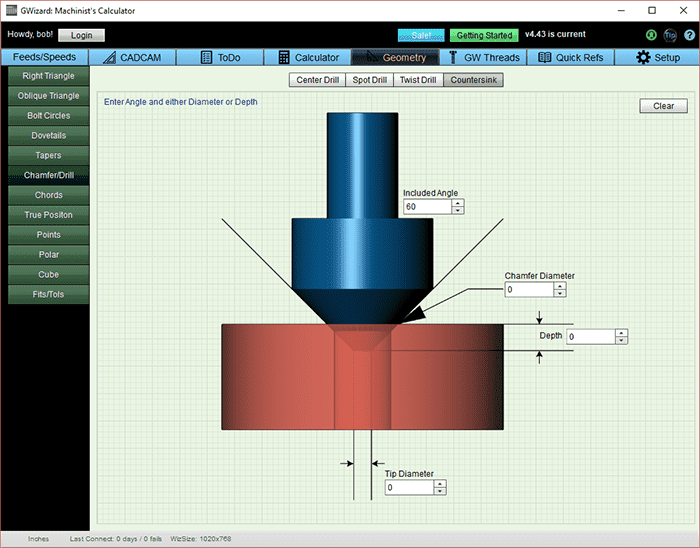

- Bit resolution calculator manual#
- Bit resolution calculator series#
An application, DC Accuracy Calculator, is attached in the Downloads section in order to calculate the accuracy of most C Series Modules.See the image below for an example of what values to use.Īll of the above specifications can be found in a datasheet or specifications of a component. See notes in additional information section. InputNoise- is the error introduced to a measurement by the device itself.In the datasheet it might be specified in ppm instead of %, for the conversion to percentage use 1%= 10,000ppm. OffsetError- the maximum offset error.Range- the reading span that the device is configured for.Gain Error- a raw % accuracy based on the input gain.Input Reading- is the value that the user is trying to measure.This accuracy entry accounts for temperature variations, worst case component tolerances, thermal hysteresis, etc.Ībsolute Accuracy = ±

Bit resolution calculator manual#
You can obtain the parameter values in the above equation by looking at the information found in each component's specifications, manual or datasheet.Ĭ Series Modules provide concise specifications for users to determine their accuracy throughout the entire operating temperature range (Calibrated Maximum -40 to 70). See notes in additional information section. **This accounts for errors introduced by ambient temperature variation. This will often depend on filter settings or whether a single sample is taken as opposed to multiple samples being averaged SystemNoise is the error introduced to the measurement by the device itself.Many times, this offset can be in ppm instead of % so in order to change this into %, use this conversion: 1% = 10,000 ppm
 %ofReading is a raw % accuracy based on the input gain. For example, for +- 10V, Input Voltage = 1 Input Voltage is the voltage range the device is configured for. You can obtain the parameter values in the above equation by looking at the specifications found in each component's manual, specifications or datasheet. *for a coverage factor of 3 σ and averaging 100 points NoiseUncertainty* = ( RandomNoise x 3) ÷ ( √100). OffsetError = Residual OffsetError + ( OffsetTempco x TempChangeFromLastInternalCal) + INLError. GainError = ResidualGainError + ( GainTempco x TempChangeFromLastInternalCal) + ( ReferenceTempco x TempChangeFromLastInternalCal). All equations are listed below:Ībsolute Accuracy =± Depending upon the presentation of different errors, there are three different equations to use to calculate the accuracy. A 16-bit color needs 2 bytes of information per pixel, while a 24-bit one needs 3.Next, calculate the Absolute Accuracy for each component.įor any individual device with gain (either an amplifier or attenuator), for a specified nominal range, NI provides an absolute accuracy specification in millivolts. If you use 8-bit colors, each pixel has to store 8 bits of information (equivalent to 1 byte). The higher the color depth, the bigger the data size of every pixel. If you choose to have a 16-bit color depth, you can encode 2¹⁶, that is, 4096 different colors. For example, in 8-bit color depth, each pixel can have one of 2⁸ = 256 colors. This phrase means nothing else than the number of bits used to indicate the color of each pixel. Secondly, the frame size depends on the color depth. Each pixel is a piece of data to be saved thus, the better the resolution, the bigger the frame size. Resolution is usually expressed as the number of pixels in the horizontal and vertical dimensions. The data size of such an image depends on several parameters.įirst of all, the size of a frame is connected with the resolution - the number of pixels that can be displayed. A video frame is one of many images that the whole "moving picture" is comprised of.
%ofReading is a raw % accuracy based on the input gain. For example, for +- 10V, Input Voltage = 1 Input Voltage is the voltage range the device is configured for. You can obtain the parameter values in the above equation by looking at the specifications found in each component's manual, specifications or datasheet. *for a coverage factor of 3 σ and averaging 100 points NoiseUncertainty* = ( RandomNoise x 3) ÷ ( √100). OffsetError = Residual OffsetError + ( OffsetTempco x TempChangeFromLastInternalCal) + INLError. GainError = ResidualGainError + ( GainTempco x TempChangeFromLastInternalCal) + ( ReferenceTempco x TempChangeFromLastInternalCal). All equations are listed below:Ībsolute Accuracy =± Depending upon the presentation of different errors, there are three different equations to use to calculate the accuracy. A 16-bit color needs 2 bytes of information per pixel, while a 24-bit one needs 3.Next, calculate the Absolute Accuracy for each component.įor any individual device with gain (either an amplifier or attenuator), for a specified nominal range, NI provides an absolute accuracy specification in millivolts. If you use 8-bit colors, each pixel has to store 8 bits of information (equivalent to 1 byte). The higher the color depth, the bigger the data size of every pixel. If you choose to have a 16-bit color depth, you can encode 2¹⁶, that is, 4096 different colors. For example, in 8-bit color depth, each pixel can have one of 2⁸ = 256 colors. This phrase means nothing else than the number of bits used to indicate the color of each pixel. Secondly, the frame size depends on the color depth. Each pixel is a piece of data to be saved thus, the better the resolution, the bigger the frame size. Resolution is usually expressed as the number of pixels in the horizontal and vertical dimensions. The data size of such an image depends on several parameters.įirst of all, the size of a frame is connected with the resolution - the number of pixels that can be displayed. A video frame is one of many images that the whole "moving picture" is comprised of.







 0 kommentar(er)
0 kommentar(er)
